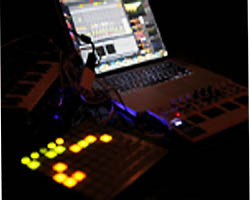This article is about a shift in perspective mostly. It’s about really embracing the tools you already have and using them to their fullest potential.
For example, I have a 12-channel Mackie mixer that I double as an analog external summing amp. It contains FX sends and returns, allowing me to utilize any number of effects units (not to mention plug ins), which can be brought back in to the stereo bus or run parallel.
I also use this mixer to control every piece of audio/visual equipment in my apartment from my bedside.
Thus rises the essence of my point. If you look, there is most likely more at your fingertips than you would realize.
Here are a few other ideas:
Digital Distortion
Exceeding 0 dBFS is not necessarily always a bad thing. In fact, it can be used in many recurring situations. I often use it as an effect to gain an overload distortion quality which may sometimes work inherently with guitar tracks, certain vocal tracks, and definitely synthesizers.
It can also be used to achieve a distorted lo-fi effect or an over-compressed quality without using an actual compressor.
Elastic Audio
One of the main goals when using elastic audio is to mask the fact that you are using elastic audio. Instead of taking this approach, try embracing the imperfections inherent to the recalculation of waveforms. Stretching or compressing waveforms drastically can produce extremely unique processing errors, using a monophonic algorithm for a polyphonic instrument can produce interesting aliases, and using the varispeed algorithm on anything can produce seemingly infinite outcomes.
Buffer Size
For a unique glitch effect, drop your playback engine’s buffer size to its lowest playable setting and record the output to a separate track. This allows you to practically “audiosuite” a decrease in buffer size for specific instruments (or across the board if you’re feeling frisky).
Delay Compensation
Delay compensation can be used similarly to the buffer size. Additionally, when combined with precise time adjustments between different tracks, rhythmic feels can be solidified as well as totally phased out of control. There are many effects that can be attained, either in plug-in form, or using the “audiosuite” method.
A word of advice on opinions… f*ck everyone else.. try things for yourself.
Precautions
First of all, nothing is the end of the world (except the apocalypse) and there will always be more work (until the apocalypse). The music will go on (until the apocalypse).
That being said, there are very good reasons for a lot of the precautions taken within a DAW recording environment.
Now, I’m not necessarily saying go out and get the trashiest plug-ins that you can and try to figure out how to make them work for you (unless you want to, which would be kick-ass), but keeping this perspective allows you to work better with the tools you already have, and allows for your DAW to be a creative landscape, as a canvas on which to draw, rather than a harsh digital program to which you must adhere.
You and the DAW are just as flawed as each other in that your existence and the becoming of that existence are of imperfect origin. Therefore, just as you have to overcome imperfections in yourself, you must overcome the imperfections inherent to any piece of equipment. Besides, didn’t you get in this to push buttons, turn knobs and have total control? So take it.
Samuel O’Sullivan has been playing various instruments and composing within the bounds and mixtures of multiple genres for more than 10 years. He first established as a drummer/percussionist, has made his mark as a guitarist, vocalist, pianist, violinist, composer, and recording engineer. In addition to producing albums for various bands, O’Sullivan produces his own music under the name “A Mess of a Mind”.
Be sure to visit the Pro Audio Files for more great recording content.





















